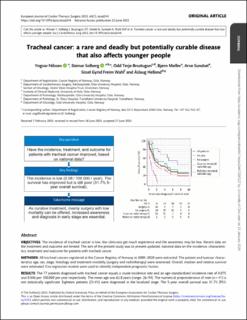| dc.contributor.author | Nilssen, Yngvar | |
| dc.contributor.author | Solberg, Steinar | |
| dc.contributor.author | Brustugun, Odd Terje | |
| dc.contributor.author | Møller, Bjørn | |
| dc.contributor.author | Sundset, Arve | |
| dc.contributor.author | Wahl, Sissel Gyrid Freim | |
| dc.contributor.author | Helland, Åslaug | |
| dc.date.accessioned | 2024-01-24T08:40:14Z | |
| dc.date.available | 2024-01-24T08:40:14Z | |
| dc.date.created | 2023-11-27T11:42:32Z | |
| dc.date.issued | 2023 | |
| dc.identifier.issn | 1010-7940 | |
| dc.identifier.uri | https://hdl.handle.net/11250/3113474 | |
| dc.description.abstract | OBJECTIVES
The incidence of tracheal cancer is low, few clinicians get much experience and the awareness may be low. Recent data on the treatment and outcome are limited. The aim of the present study was to present updated, national data on the incidence, characteristics, treatment and outcome for patients with tracheal cancer.
METHODS
All tracheal cancers registered at the Cancer Registry of Norway in 2000–2020 were extracted. The patient and tumour characteristics age, sex, stage, histology and treatment modality (surgery and radiotherapy) were examined. Overall, median and relative survival were estimated. Cox regression models were used to identify independent prognostic factors.
RESULTS
The 77 patients diagnosed with tracheal cancer equals a crude incidence rate and an age-standardized incidence rate of 0.075 and 0.046 per 100,000 per year respectively. The mean age was 63.8 years (range: 26–94). The numerical preponderance of men (n = 41) is not statistically significant. Eighteen patients (23.4%) were diagnosed in the localized stage. The 5-year overall survival was 31.7% [95% confidence interval (CI): 21.0–42.9], and in those treated with surgical resection or curative radiotherapy, it was 53.7% (95% CI: 26.1–75.0) and 37.8% (95% CI: 18.8–56.7), respectively. Age, histological type and treatment modality were identified as independent prognostic factors.
CONCLUSIONS
Despite improved survival, the prognosis for patients with tracheal cancer is still poor. Few are diagnosed in the early stage and thus most are not eligible for curative treatment, mainly surgery. An increased awareness and diagnosis in the earlier stage is crucial. | en_US |
| dc.language.iso | eng | en_US |
| dc.publisher | Oxford University Press | en_US |
| dc.rights | Navngivelse-Ikkekommersiell 4.0 Internasjonal | * |
| dc.rights.uri | http://creativecommons.org/licenses/by-nc/4.0/deed.no | * |
| dc.title | Tracheal cancer: a rare and deadly but potentially curable disease that also affects younger people | en_US |
| dc.title.alternative | Tracheal cancer: a rare and deadly but potentially curable disease that also affects younger people | en_US |
| dc.type | Peer reviewed | en_US |
| dc.type | Journal article | en_US |
| dc.description.version | publishedVersion | en_US |
| dc.source.volume | 3 | en_US |
| dc.source.journal | European Journal of Cardio-Thoracic Surgery | en_US |
| dc.source.issue | 64 | en_US |
| dc.identifier.doi | 10.1093/ejcts/ezad244 | |
| dc.identifier.cristin | 2202844 | |
| dc.relation.project | Norges forskningsråd: 328827 | en_US |
| dc.relation.project | Helse Sør-Øst RHF: 2016056 | en_US |
| cristin.ispublished | true | |
| cristin.fulltext | original | |
| cristin.qualitycode | 1 | |

